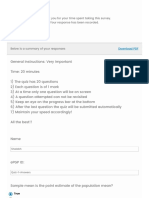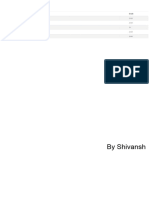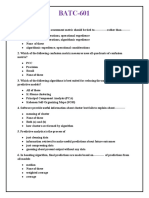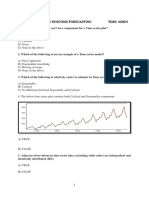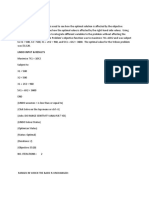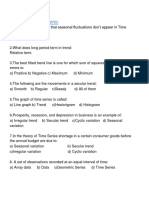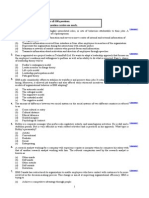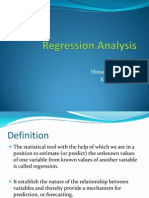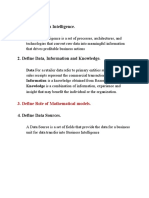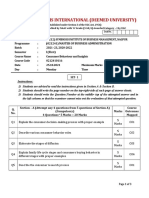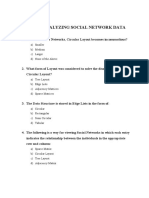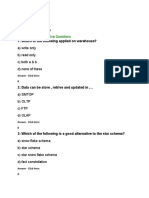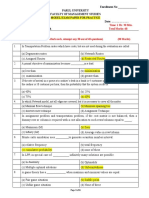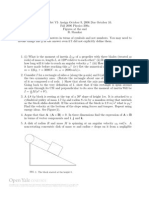Decision Science MOCK TEST 1 With Answer Key
Uploaded by
Shubham JadhavDecision Science MOCK TEST 1 With Answer Key
Uploaded by
Shubham JadhavDecision Science
Multiple Choice Questions
1Questi The field of management science
on
A concentrates on the use of quantitative methods to assists in decision making
B approaches decision making with techniques based on the scientific method
C is another name for decision science and for operation research
D each of the above is true
2Questi Identification and definition of a problem
on
A cannot be done until alternatives are proposed
B is the first step of decision making
C is the final step of problem solving
D requires consideration of multiple criteria
3Questi The application of DS techniques involves ………… approach
on
A Individual
B Team
C Critical
D None of the above
4Questi To balance an assignment matrix we have to _
on
A add a dummy row or column depending on given situation
B add a dummy row
C add a dummy column
D remove a row or column depending upon the given situation
5Questi Prohibited assignment in an assignment problem is addressed by _
on
A considering its cost as negative
B considering its cost as infinity
C considering its cost as zero
D none of the above
6Questi The quantitative analysis approach requires
on
A the managers prior experience with similar problem
B a relatively uncomplicated problem
C mathematical expressions for the relationship
D each of the above is true
7Questi Maximization or minimization of the quantity is the
on
A a goal of management science
B decision for decision analysis
C constraint of operation research
D objective of linear programming
8Questi Decision variables
on
A tells us how much or how many of something to produce, invest, purchase, hire
B represent the values of the constraints
C measure the objective function
D must exist for each constraint
9Questi Which of the following is the valid objective function of LPP?
on
A Maximize 5xy
B Minimize 4x+3y+3z
C Maximize 3xy+5xy
D Minimize (x1+x2)/x3
10Quest Which of the following statement is not true?
ion
A feasible solution satisfies all the constraints
B an optimal solution satisfies all the constraints
C an infeasible solution violates all constraints
D a feasible solution point does not have to lie on the boundary of the feasible region
11Quest A solution that satisfies all the constraints of the LPP except the non-negativity constraints
ion is called
A optimal
B feasible
C infeasible
D semi-feasible
12Quest Flood's technique of solving an assignment matrix uses the concept of ____________
ion
A maximum cost
B minimum cost
C opportunity cost
D negative cost
13Quest To find the optimal solution to the LPP using the graphical method
ion
A find the feasible point that is the farthest away from the region
B find the feasible point that is at the highest location
C find the feasible point that is closest to the origin
D None of the alternative is correct
14Quest If all the constraints are of less than or equal to type the feasible region is -----
ion
A closed
B open
C unbounded
D optimum
15Quest Whenever all constraints in the LPP are expressed as equalities, the linear program is said
ion to be written in
A Standard form
B Bounded form
C Feasible form
D Alternate form
16Quest Problem solving encompasses
ion
A Identification of problem
B Identification of problem and the action to resolve it
C Identification of problem and finding of objective function
D All of above
17Quest Long form of LPP is
ion
A Linear programming problem
B Linear Problem parameters
C Linear programming parameters
D None of above
18Quest Assignment model can be applied in
ion
A Decision making
B Problem solving
C Manufacturing Industry
D Only in service sector
19Quest A dummy job is
ion
A Imaginary
B Real
C Rigid
D Can’t say
20Quest In transportation problem following are always transported
ion
A Consignments
B Goods
C Demand
D Supply
21Quest Initial basic solution from VAM IS
ion
A Least
B Maximum
C Can’t say
D None of above
22Quest Demand variation occurs because of change in
ion
A Customer preference
B Competitors entry
C Market condition
D None of above
23Quest Following represents the aim or goal of the system
ion
A Decision variable
B Objective function
C Constraints
D None of above
24Quest In real life supply & demand requirement will be rarely
ion
A Equal
B Unequal
C Stable
D None of above
25Quest LPP is widely used ……………… modelling technique
ion
A Mathematical
B Statistical
C Graphical
D None of above
DECISION SCIENCE
Multiple Choice Questions
LP consists of linear objectives & ……………….
1.Question
A Linear variables
B Linear constraints
C Linear functions
D None of above
2.Question .………………… represents the aim of the system.
A Constraints
B Decision variable
C Objective functions
D Can’t say
3.Question If the assignment matrix is not optimal (after drawing the lines) then to improve it, one
of the action is to ________
A add smallest uncovered element to the elements on the lines
B subtract smallest uncovered element from the inter section elements of the lines
C subtract smallest uncovered element from all uncovered elements
D subtract smallest element from the elements on the lines
4.Question ……………. is special type of linear programming
A Transportation problem
B Assignment
C Can’t say
D Queuing
5.Question …………… model helps the manager to take decision
A Transportation
B Assignment
C LPP
D All above
6.Question ……………is used to collect a set of experimental data and figure out to graph
A LPP
B Mathematical model
C Corner point model
D Operation research model
7.Question Initial basic solution can be obtained by modified distribution method
A True
B False
C Can't say
D Data is not sufficient
8.Question Least cost method is a best method to find basic solution
A True
B False
C Can't say
D Data is not sufficient
9.Question …………. method is more accurate.
A North west corner
B Least cost
C VAM
D None of above
10.Questio In a balanced transportation model where supply equals demand,
n
A all constraints are equalities
B none of the constraints are equalities
C all constraints are inequalities
D none of the constraints are inequalities
11.Questio In a transportation problem, items are allocated from sources to destinations
n
A at a maximum cost
B at a minimum cost
C at a minimum profit
D at a minimum revenue
12.Questio The assignment model is a special case of the ________ model.
n
A maximum-flow
B transportation
C shortest-route
D none of the above
13.Questio The linear programming model for a transportation problem has constraints for supply
n at each ______.
A destination
B source
C demand
D None of above
14.Questio An assignment problem is a special form of transportation problem where all supply and
n demand values equal
A 0
B 1
C 2
D 3
15.Questio To convert the assignment problem from maximisation problem to minimisation
n problem.................
A deduct smallest element in the matrix from all other elements
B deduct all elements of the matrix from the largest element in it
C deduct smallest element of each row from other elements in it
D deduct all elements of each row from the largest element in it
16.Questio The assignment problem _
n
A requires that only one activity be assigned to each resource
B is a special case of transportation problems
C can be used for maximization objective
D all of the above
17.Questio An optimum assignment requires that the minimum number of lines which can be drawn
n through the squares with zero opportunity cost to be equal to the number of _________
A rows or columns
B rows and columns
C rows + columns - 1
D rows + columns + 1
18.Questio If arrival rate at shop is 20 customer per hour and service rate is 30 customers per hour.
n The traffic intensity is
A 0.6
B 0.45
C 0.57
D 0.67
19.Questio The property of the optimum assignment matrix is_______
n
A it will have zero as elements of one diagonal
B it will have zero as elements of at least one row or column
C it will have atleast one zero in each row and column
D it will not have zero as its element
20.Questio In Hungarian method of solving assignment problems, the row opportunity cost matrix
n is obtained by _______
A subtracting all elements of the row from the largest element in the row
B subtracting smallest element in the row from all the elements of the row
C subtracting all elements of the row from the largest element in the matrix
D dividing each element by smallest uncovered element
21.Questio In MODI method a closed path has been drawn for a suitable unoccupied cell in a non-
n optimum table. The allocations at the consecutive corner cells along the path (starting
from the unoccupied cell) are: 0, 5, 10, 6, 8, 4 units respectively. Hence, the number of
units to be shifted to the unoccupied cell along the closed path for improving the
solution are _______
A 5
B 6
C 8
D 4
22.Questio Assignment problem is solved by ___
n
A Simplex method
B Graphical method
C Vector method
D Hungarian method
23.Questio In the optimum transportation table, an unoccupied cell has per unit cost of Rs.11 and
n opportunity cost of 5. This cell will become suitable for optimum allocation only when
___________
A its cost is reduced to atleast 6
B its cost is reduced to atleast 0
C its cost is increased to atleast 16
D its cost is reduced to atleast 5
24.Questio The prohibited cell in transportation problem is considered by treating its cost as
n
A 0
B - infinity
C 0
D negative
25.Questio Transportation problem is basically a ---
n
A iconic model
B transshipment model
C maximization model
D minimization model
DECISION SCIENCE
Multiple Choice Questions
The opportunity cost/penalty of a row in VAM is obtained by __
1.Question
A deducting smallest element in the row from all other elements of the row
B deducting the smallest element in the row from the next highest element of the row
C deducting smallest element from the highest element of the row
D adding smallest element in the row to the next highest element of the row
Answer B
2.Question MODI stands for
A modern distributions
B markov distribution method
C modified distribution method
D model index method
Answer C
3.Question Allocations to the dummy row cells in the optimum solution of a transportation problem
indicate __
A Unutilised resources at the respective origins
B shortage of resources of the respective origins
C unutilised demand at the respective destinations
D unfulfilled demand at the respective destinations
Answer D
4.Question To solve a transportation problem for maximisation, the relative loss matrix is obtained
by __
A subtracting all elements from the largest element of the matrix
B subtracting smallest element from all elements of the matrix
C treating maximum elements at 00
D adding a dummy row or column
Answer A
5.Question Multiple optimal solutions for a transportation problem are indicated in the Optimum
table by
A occupied cells with positive opportunity costs
B unoccupied cells with zero opportunity costs
C occupied cells with zero opportunity costs
D unoccupied cells with positive opportunity costs
Answer B
6.Question The purpose of simulation technique is to _________
A create a real world situation
B avoid cost of experimenting on real situation
C approximately understand the behavior of real life situation
D all of the above
Answer D
7.Question The length of a queue
A could be finite
B could be infinite
C can constantly change
D all of the above
Answer D
8.Question Items may be taken from a queue
A on a first-come-first-serve basis
B on a last-come-first-serve basis
C according to the due date of the item
D All of above
Answer D
9.Question Which of the following items is not a part of the queuing system?
A arrival rate
B service facility
C waiting line
D activity flow
Answer D
10.Questio In a single-server queuing model, the expected number of customers in the service is
n calculated by dividing the arrival rate by:
A service rate
B service time
C service rate minus arrival rate
D service rate plus arrival rate
Answer A
11.Questio The most important factors to consider in analyzing a queuing system are
n
A the service and arrival rate
B the nature of the calling population
C the queue discipline
D all of the above
Answer B
12.Questio Queuing analysis is a deterministic technique.
n
A True
B False
C Can't say
D Data is not sufficient
Answer A
13.Questio The operating characteristics of a queuing system provide information rather than an
n optimization of a queuing system.
A True
B False
C Can't say
D Data is not sufficient
Answer B
14.Questio While using random numbers in Monte Carlo Simulation it is __
n
A not necessary to assign the exact range of random numbers
B necessary to find out the cumulative probability distribution
C necessary to use particular random numbers
D none of the above
Answer B
15.Questio In Monte Carlo Simulation Random numbers are used to
n
A calculate the probabilities
B calculate cumulative probabilities
C simulate the values of the variable
D summarise the output
Answer C
16.Questio Simulation, not being an analytical method, its results must be viewed as __
n
A unrealistic
B exact
C approximation
D simplified
Answer C
17.Questio In the transition probability matrix, the diagonal elements represents the probability of
n
A gain
B loss
C transition
D retention
Answer D
18.Questio If Ro represent state probabilities of present period then the state probabilities at the end
n of second period are given by _
A R2 = Rl x p2
B R2 = R0 x p2
C R2 = P x Rl
D none of the above
Answer B
19.Questio Which of the following is not an assumption of Markov Analysis?
n
A The number of possible states are limited
B The transition probabilities are not changed over time
C There are limited number of future periods
D Future state can be predicted from preceding state
Answer C
20.Questio While calculating the state probabilities for a Markov process, it is assumed that __
n
A there is a single absorbing state
B transition probabilities remain unchanged
C there is a single non-absorbing state
D none of the above
Answer B
21.Questio In graphical solution of solving LP problem, to convert inequalities into equations we
n
A use slack variables
B use surplus variables
C draw lines
D simply assume them as equations
Answer D
22.Questio The distinguishing feature of an LP model is __
n
A relationship among all the variables is linear
B it has single objective function and constraints
C value of the decision variables is non-negative
D all of the above
Answer A
23.Questio The first step in a solving decision science problem is
n
A Model Building
B Obtain alternate solution
C Interpreting the variables
D Formulation of the problem
Answer D
24.Questio The distinguishing features of an LPP model is
n
A Relationship among all the variable is linear
B It has single objective function and constraints
C Value of decision variable is non negative
D All of above
Answer A
25.Questio LPP techniques can be applied when values of the constraints are
n
A uncertain
B known
C unknown
D certainly known
Answer D
DECISION SCIENCE
Multiple Choice Questions
Resources in a LP problem are indicated by
1.Question
A Objective function
B Decision variables
C Constraints
D Slack variables
Answer C
2.Question Opportunity loss refers to
A the expected value of a bad decision.
B the expected loss from a bad decision.
C the difference between the actual payoff and the optimal payoff.
D the regret from not having made a decision.
Answer C
3.Question Dummy source or destination has----- cost of transportation in each of the cell
A Positive C Higest
B Negative D Zero
4.Question Unbalanced TP is balanced by inserting either -------- supply or destination
A dummy
B factory
C warehouse
D exact
Answer D
5.Question In transportation problem each destination point has------- for the goods supplied
A demand
B capacity
C supply
D warehouse
Answer A
6.Question Single destinations can receive supply from ------- supply points
A various
B single
C two
D unknown
Answer A
7.Question If total capacity and total demand in TP are equal then problem is called----
A correct
B square
C balanced
D incorrect
Answer C
8.Question If total capacity and total demand in TP are not equal the problem is called----
A balanced
B regular
C irregular
D unbalanced
Answer D
9.Question Which of the following is a property of all linear programming problems?
A alternate courses of action to choose from
B minimization of some objective
C a computer program
D usage of graphs in the solution
Answer A
10.Questio A point that satisfies all of a problem's constraints simultaneously is a
n
A maximum profit point.
B corner point.
C intersection of the profit line and a constraint.
D None of the above
Answer D
11.Questio The first step in formulating an LP problem is
n
A Graph the problem
B Understand the managerial problem being faced
C Identify the objective and the constraint
D define the decision variables
Answer B
12.Questio LP theory states that the optimal solution to any problem will lie at
n
A the origin.
B a corner point of the feasible region.
C the highest point of the feasible region.
D the lowest point in the feasible region.
Answer B
13.Questio Management science and operations research both involve
n
A qualitative managerial skills.
B quantitative approaches to decision making.
C operational management skills.
D scientific research as opposed to applications.
Answer B
14.Questio Which of the following does not represent a factor a manager might consider when
n employing linear programming for a production scheduling?
A labor capacity
B employee skill levels
C warehouse limitations
D none of the above
Answer D
15.Questio In labour planning formulation, how would you write the constraint that there are only
n 10 full-time tellers (labeled as T) available?
A T + 10 > 0
B T > 10
C T ≤10
D All of the above are correct ways.
Answer C
16.Questio A type of linear programming problem that is used in marketing is called the
n
A media selection problem.
B Madison Avenue problem.
C marketing allocation problem.
D all of the above
Answer A
17.Questio The maximization or minimization of a quantity is the
n
A goal of management science.
B decision for decision analysis.
C constraint of operations research.
D objective of linear programming.
Answer D
18.Questio Decision variables
n
A tell how much or how many of something to produce, invest, purchase, hire, etc.
B represent the values of the constraints.
C measure the objective function.
D must exist for each constraint.
Answer A
19.Questio Which of the following is a valid objective function for a linear programming problem?
n
A Max 5xy
B Min 4x + 3y + (2/3)z
C Max 5x2+ 6y2
D Min (x1 + x2)/x3
Answer B
20.Questio Which of the following statements is NOT true?
n
A A feasible solution satisfies all constraints.
B An optimal solution satisfies all constraints.
C An infeasible solution violates all constraints.
D A feasible solution point does not have to lie on the boundary of the feasible region.
Answer C
21.Questio A solution that satisfies all the constraints of a linear programming problem except the
n non-negativity constraints is called
A optimal.
B feasible.
C infeasible.
D semi-feasible.
Answer C
22.Questio In transportation problem each supply point has---- to provide goods
n
A demand
B vehicles
C capacity
D facilities
Answer C
23.Questio LPP technique does not take in to account the effect of
n
A variables
B time
C constants
D resources
Answer B
24.Questio Unboundedness is usually a sign that the LP problem
n
A has finite multiple solutions.
B is degenerate .
C contains too many redundant constraints.
D has been formulated improperly.
Answer D
25.Questio To find the optimal solution to a linear programming problem using the graphical
n method one has to
A find the feasible point that is the farthest away from the origin.
B find the feasible point that is at the highest location.
C find the feasible point that is closest to the origin.
D None of the alternatives is correct.
Answer D
DECISION SCIENCE
Multiple Choice Questions
1.Question Which of the following special cases does not require reformulation of the problem in
order to obtain a solution?
A alternate optimality
B infeasibility
C unboundedness
D each case requires a reformulation.
Answer A
2.Question Whenever all the constraints in a linear program are expressed as equalities, the linear
program is said to be written in
A standard form.
B bounded form.
C feasible form.
D alternative form.
Answer A
3.Question In applying Vogel's approximation method, row and column penalties are determined
by:
A finding the largest unit cost in each row or column.
B finding the smallest unit cost in each row or column.
C finding the difference between the two lowest unit costs in each row and column.
D finding the difference between the two highest unit costs in each row and column.
Answer C
4.Question The northwest corner rule requires that we start allocating units to shipping routes in
the:
A middle cell.
B Lower right corner of the table.
C Upper right corner of the table.
D Upper left-hand corner of the table.
Answer D
5.Question In a transportation problem, when the number of occupied routes is less than the numbe
of rows plus the number of columns -1, we say that the solution is:
A Unbalanced.
B Degenerate.
C Infeasible.
D Optimal.
Answer B
6.Question The restriction can be placed on the initial solution of a transportation problem is that:
A must have nonzero quantities in a majority of the boxes.
B must have a number (equal to the number of rows plus the number of columns minus
one) of boxes which contain nonzero quantities.
C demand must equal supply.
D all constraints must be satisfied.
Answer D
7.Question Which of the following is used to come up with a solution to the assignment problem?
A MODI method
B northwest corner method
C stepping-stone method
D Hungarian method
Answer D
8.Question The Transportation problem matrix can have----- no of supply points
and destinations
A same
B different
C minimum
D infinite
Answer B
9.Question Which method usually gives a very good solution to the transportation problem?
A Northwest corner rule
B Vogel's approximation method
C MODI method
D Stepping-stone method
Answer B
10.Questio Infeasibility means that the number of solutions to the linear programming models that
n satisfies all constraints is
A at least 1.
B 0
C an infinite number.
D at least 2.
Answer B
11.Questio The stepping-stone method requires that one or more artificially occupied cells with a
n flow of zero be created in the transportation table when the number of occupied cells is
fewer than
A m+n−2
B m+n−1
C m+n
D m+n+1
Answer B
12.Questio The objective of transportation problem involves ------ of shipping
n
cost
A maximization
B minimization
C optimization
D calculation
Answer B
13.Questio The difference between the transportation and assignment problems is that
n
A total supply must equal total demand in the transportation problem
B the number of origins must equal the number of destinations in the transportation
problem
C one supply point can be assigned to one demand center in the assignment problem
D there are many differences between the transportation and assignment problems
Answer C
14.Questio An example of a heuristic is the
n
A minimum-cost method.
B stepping-stone method.
C Hungarian method.
D MODI method.
Answer A
15.Questio A solution to a transportation problem that has less than m + n − 1 cells with positive
n allocations in the transportation table is
A an optimal solution.
B an initial feasible solution.
C a minimum-cost solution.
D a degenerate solution.
Answer D
16.Questio A linear constraint appears to be ----- when plotted on graph
n
A circle
B infinite
C straight line
D non linear
Answer C
17.Questio An analyst is simulating demand, which is hypothesized to follow a uniform distribution
n in the range of [20, 39]. Allowing only integer values, picking 2 digits at random
numbers and associating 00-04 with 20, 05-09 with 21, etc., what will be the simulated
demand corresponding to a random number choice of 43?
A 25
B 26
C 27
D 28
Answer 28
18.Questio To use the transportation method, a transportation problem that is unbalanced requires
n the use of
A artificial variables.
B one or more transshipment nodes.
C a dummy origin or destination.
D matrix reduction.
Answer C
19.Questio The problem which deals with the distribution of goods from several sources to several
n destinations is the
A maximal flow problem
B transportation problem
C assignment problem
D shortest-route problem
Answer B
20.Questio The optimal solution is found in an assignment matrix when the minimum number of
n straight lines needed to cover all the zeros equals
A (the number of agents) − 1.
B (the number of agents).
C (the number of agents) + 1.
D (the number of agents) + (the number of tasks).
Answer B
21.Questio The objective of the transportation problem is to
n
A identify one origin that can satisfy total demand at the destinations and at the same time
minimize total shipping cost.
B minimize the number of origins used to satisfy total demand at the destinations.
C minimize the number of shipments necessary to satisfy total demand at the destinations
D minimize the cost of shipping products from several origins to several destinations.
Answer D
22.Questio Which of the following is not true regarding the linear programming formulation of a
n transportation problem?
A Costs appear only in the objective function.
B The number of variables is (number of origins) × (number of destinations).
C The number of constraints is (number of origins) × (number of destinations).
D The constraints' left-hand side coefficients are either 0 or 1.
Answer C
23.Questio In the general linear programming model of the assignment problem,
n
A one agent can do parts of several tasks.
B one task can be done by several agents.
C each agent is assigned to its own best task.
D one agent is assigned to one and only one task.
Answer D
24.Questio Which of the following is not true regarding an LP model of the assignment problem?
n
A Costs appear in the objective function only.
B All constraints are of the ≥ form.
C All constraint left-hand side coefficient values are 1.
D All decision variable values are either 0 or 1.
Answer B
25.Questio The assignment problem constraint x31 + x32 + x33 + x34 ≤ 2 means
n
A agent 3 can be assigned to 2 tasks.
B agent 2 can be assigned to 3 tasks.
C a mixture of agents 1, 2, 3, and 4 will be assigned to tasks.
D there is no feasible solution.
Answer A
Decision Science
Multiple Choice Questions
In a linear programming formulation of the assignment problem, the RHS of all
1.Question constraints is greater than 1.
A TRUE
B FALSE
C Can't say
D Data is not sufficient
Answer B
2.Question In a transportation problem with total demand equal to 1200 and total supply equal to
900, we should add a _______________ with a quantity equal to___________ to
convert it to a balanced problem.
A Dummy supply, 300
B Dummy supply, 2100
C Dummy demand, 300
D Dummy demand, 2100
Answer A
3.Question All linear programming problems may be solved using graphical method.
A TRUE
B FALSE
C Can't say
D Data is not sufficient
Answer B
4.Question All linear programming problems with only two variables may be solved using
graphical method.
A TRUE
B FALSE
C Can't say
D Data is not sufficient
Answer A
5.Question In any graphically solvable linear program, if two points are feasible, then any weighted
average of the two points where weights are non-negative and add up to 1.0 will also be
feasible.
A TRUE
B FALSE
C Can't say
D Data is not sufficient
Answer A
6.Question If a graphically solvable linear program is unbounded, then it can always be converted
to a regular bounded problem by removing a constraint.
A TRUE
B FALSE
C Can't say
D Data is not sufficient
Answer B
7.Question A two variable linear programming problem cannot be solved by the simplex method.
A TRUE
B FALSE
C Can't say
D Data is not sufficient
Answer B
8.Question A two variable linear programming problem can only be solved by the simplex method.
A TRUE
B FALSE
C Can't say
D Data is not sufficient
Answer B
9.Question If the sale of first 10 units of a product gives a profit of Rs10.00 per unit and every
additional unit sold gives a profit of Rs15.00 per unit, the situation can not be modeled
easily as a linear program.
A TRUE
B FALSE
C Can't say
D Data is not sufficient
Answer A
10.Questio Sensitivity analysis answers "what if" questions to help the decision maker
n
A TRUE
B FALSE
C Can't say
D Data is not sufficient
Answer A
11.Questio In a two variable graphical linear program, if the coefficient of one of the variables in
n the objective function is changed (while the other remains fixed), then slope of the
objective function expression will change.
A TRUE
B FALSE
C Can't say
D Data is not sufficient
Answer A
12.Questio In a two variable graphical linear program, if the RHS of one of the constraints is
n changed (keeping all other things fixed) then the plot of the corresponding constraint
will move in parallel to its old plot.
A TRUE
B FALSE
C Can't say
D Data is not sufficient
Answer A
13.Questio Dual of a linear programming problem with maximize objective function, all ≤
n constraints and non-negative variables has minimize objective function, all ≥ constraints
and non-negative decision variables.
A TRUE
B FALSE
C Can't say
D Data is not sufficient
Answer A
14.Questio Markov Analysis has many business applications such as accounts receivables analysis
n and machine maintenance.
A TRUE
B FALSE
C Can't say
D Data is not sufficient
Answer A
15.Questio In Markov systems, the probability of going from one state in period n to another state
n in period (n+1) depends on what states the system traveled in periods 1,2,...,n.
A TRUE
B FALSE
C Can't say
D Data is not sufficient
Answer B
16.Questio The states in a Markov system are mutually exclusive and collectively exhaustive
n
A TRUE
B FALSE
C Can't say
D Data is not sufficient
Answer A
17.Questio If matrix A is multiplied by matrix B, (A.B), then the number of rows in A should equal
n the number of columns in B.
A TRUE
B FALSE
C Can't say
D Data is not sufficient
Answer B
18.Questio Judy Jones purchases groceries and pop exactly once each week on Sunday evenings.
n She buys either Coke or Pepsi only and switches from Coke to Pepsi and vice-versa sort
of regularly. Her purchasing behavior of these two drinks is modeled as a Markov
system. Querying Judy, a novice student came up with the following transition matrix.
Does this matrix satisfy all the conditions for being a transition matrix?
Coke Pepsi
Coke 0.7 0.3
Pepsi 0.4 0.6
A TRUE
B FALSE
C Can't say
D Data is not sufficient
Answer A
19.Questio An advantage of simulation is that decision makers can see the effects of a policy over
n several years before making a decision
A TRUE
B FALSE
C Can't say
D Data is not sufficient
Answer A
20.Questio In simulation several alternatives are evaluated and one chooses the best among the
n alternatives evaluated.
A TRUE
B FALSE
C Can't say
D Data is not sufficient
Answer A
21.Questio Using simulation, one can exhaust all possible options for a problem and thus find the
n optimal solution, though it may take a little longer computation time.
A TRUE
B FALSE
C Can't say
D Data is not sufficient
Answer B
22.Questio Using simulation, one should be able to find the optimal solution in a reasonable amoun
n of computation time.
A TRUE
B FALSE
C Can't say
D Data is not sufficient
Answer B
23.Questio For constraints of the type ≤ we mark the feasible region as
n
A The region not containing origin
B The region containing the origin
C The region on the line
D The region in the first quadrant
Answer D
24.Questio An isoprofit line represents
n
A An infinite number of solutions all of which yield the same profit
B An infinite number of solutions all of which yield the maximum profit
C An infinite number of optimum solution
D A boundry of the feasible region
Answer A
Id 177
25.Questio In a graphical solution of minimization problem we move the Iso-cost line
n
A Towards right
B Towards left
C Towards the origin
D Away from origin
Answer C
Decision Science
Multiple Choice Questions
If a feasible region is bounded below and objective function is maximization then the
1.Question solution to the problem is called
A optimum
B optimal
C feasible
D unbounded
Answer D
2.Question If an Iso profit line yielding the optimal solution coincides with a constraints line then
A The solution is unbounded
B The solution is infeasible
C The coinciding constraints is redundant
D None of the above
Answer B
3.Question The dummy sources or destinations in a transportation problem is added to
A Satisfy the RIM condition
B Present solution from becoming degenerate
C Ensure that the total cost does not exceed a limit
D None of the above
Answer B
4.Question The solution of a transportation problem with m-rows (Supplies) and n-columns
(destinations) is feasible if the number of occupied cells are
A M+n
B M*n
C M+n-1
D M+n+1
Answer C
5.Question If all the constraints are of greater than or equal to type except non negativity constraint
the feasible region is --------
A Closed
B Bounded from below
C Not possible
D constant
Answer B
6.Question Every point inside or on the edge of the feasible region provides
A feasible solution
B optimal solution
C infeasible solution
D known solution
Answer A
7.Question For a simple queue, traffic intensity is given by
A Mean arrival rate/mean service rate
B Number present in the queue/number served
C Mean arrival time/mean service rate
D Mean arrival rate/mean service time
Answer A
8.Question Customer behaviour in which he moves from one queue to another in multiple channel
situation is
A Backing
B Reneging
C Jockeying
D Alternating
Answer C
9.Question A calling population in a queuing system is considered to be infinite when
A All the customer arrive at once
B Arrivals are independent of each other
C Arrivals are depending upon each other
D All of the above
Answer B
10.Questio Which of the following is not an assumption of the single server queuing method
n
A Service times are poisson distributed
B Queue discipline is not first came first first serve
C Mean arrival rate < mean service rate
D Arrivals follow poisson distribution
Answer A
11.Questio In a matrix of transition probability the probability values should add upto one in each
n
A Row
B Column
C Diagonal
D All of the above
Answer A
12.Questio While calculating the state probabilities for a Markov process it is assumed that
n
A There is a single absorbing state
B Transition probability remain unchanged
C There is a single non- absorbing state
D There is a single non- absorbing state
Answer A
13.Questio The field of management science
n
A concentrates on the use of quantitative methods to assist in decision making.
B approaches decision making rationally, with techniques based on the scientific method.
C is another name for decision science and for operations research.
D each of the above is true.
Answer D
14.Questio ………………… represents the aim of the system.
n
A Constraints
B Decision variable
C Objective functions
D Can’t say
Answer C
15.Questio Initial basic solution can be obtained by modified distribution method
n
A True
B False
C Cannot say
D Data is not sufficient
Answer B
16.Questio Least cost method is a best method to find basic solution
n
A True
B False
C Cannot say
D Data is not sufficient
Answer B
17.Questio The quantitative analysis approach requires
n
A the manager’s prior experience with a similar problem.
B a relatively uncomplicated problem.
C mathematical expressions for the relationships.
D mathematical expressions for the relationships.
Answer C
18.Questio A physical model that does not have the same physical appearance as the object being
n modeled is
A an analog model.
B an iconic model.
C a mathematical model.
D a qualitative model.
Answer A
19.Questio Management science and operations research both involve
n
A qualitative managerial skills.
B quantitative approaches to decision making.
C operational management skills.
D scientific research as opposed to applications.
Answer B
20.Questio A model that uses a system of symbols to represent a problem is called
n
A mathematical.
B iconic.
C analog.
D constrained.
Answer A
21.Questio The range of feasibility measures
n
A the right-hand-side values for which the objective function value will not change.
B the right-hand-side values for which the values of the decision variables will not change
C the right-hand-side values for which the dual prices will not change.
D each of the above is true.
Answer C
22.Questio The amount that the objective function coefficient of a decision variable would have to
n improve before that variable would have a positive value in the solution is the
A dual price.
B surplus variable.
C reduced cost.
D upper limit.
Answer C
23.Questio The number of units shipped from origin i to destination j is represented by
n
A xij.
B xji.
C cij.
D cji.
Answer A
24.Questio The difference between the transportation and assignment problems is that
n
A total supply must equal total demand in the transportation problem
B the number of origins must equal the number of destinations in the transportation
problem
C each supply and demand value is 1 in the assignment problem
D there are many differences between the transportation and assignment problems
Answer C
25.Questio To use the Hungarian method, a profit-maximization assignment problem requires
n
A converting all profits to opportunity losses.
B a dummy agent or task.
C matrix expansion.
D finding the maximum number of lines to cover all the zeros in the reduced matrix.
Answer A
Decision Science
Multiple Choice Questions
The transportation model relies on certain assumptions. They include all of the following
1.Questio except
n
A the items must be homogeneous
B there is only one route being used between each origin and destination
C the shipping cost per unit is the same
D none of the above
Answer D
2.Questio The basis for the transportation model is
n
A a way to provide a map for people to see results
B a method to arrive at the lowest total shipping cost
C so delivery drivers know where to go
D a form of accounting
Answer B
3.Questio Before the analysis of the transportation model can begin, what data would they need to
n collect?
A A list of destinations
B Unit cost to ship
C A list of origins
D All of the above
Answer D
4.Questio What does the transportation problem involve finding:
n
A highest cost-plan
B lowest cost-plan
C closest destinations
D farthest destinations
Answer B
5.Questio Transportation problems be solved
n
A manually
B with excel
C with software packages
D all of the above
Answer D
6.Questio The method for finding the lowest-cost plan for distributing stocks of goods or supplies
n from multiple origins to multiple destinations that demand the goods is
A cost-volume analysis
B transportation model analysis
C factor rating analysis
D linear regression analysis
Answer D
7.Questio Except to be used to minimized the costs associated with distributing good, transportation
n model can also be used in
A production planning
B capacity planning
C comparison of location alternative
D all of the above
Answer D
8.Questio Transportation problems can be solved manually in a straightforward manner except for
n
A medium problems
B very small, but time consuming problems
C large problems
D all of the above
Answer D
9.Questio The transportation model is a
n
A linear model
B quadratic model
C model with two variables
D both a and c
Answer D
10.Questi The transportation model is used to determine
on
A what type of transportation to use (boat, truck, train or plane) to transport goods, while
minimizing costs
B what day of the week goods should be transportation on to minimize costs
C how to distribute goods from multiple origins to multiple destinations to minimize total
shipping costs
D how to best package goods so that they wouldn't break while transporting them
Answer C
11.Questi What assumption is used in the transportation model?:
on
A The items to be shipped are heterogeneous.
B Shipping cost per unit is the different regardless of the number of units shipped.
C There is more than one route or mode of transportation being used between each origin
and each destination.
D The items to be shipped are the same regardless of their source or destination.
Answer D
12.Questi Which of the following is needed for a transportation model?
on
A a list of origins and each one's capacity or supply quantity per period
B a list of destinations and each one's demand per period
C the unit cost of shipping items from each origin to each destination
D all of the above
Answer D
13.Questi The transportation model is a linear __ model.
on
A solution
B programming
C data
D shipping
Answer B
14.Questi In linear programming we need to ensure that both the objective function and the
on constraints can be expressed as linear expressions of _________________.
A Objective function
B Decision variables
C Constraints
D Basic variables
Answer B
15.Questi Identify in which among the following methods does a row or column difference indicate
on the minimum unit penalty incurred by failing to make an allocation to the least cost cell in
that row or column.
A Matrix minima method
B MODI method
C Vogel’s approximation method
D North-west corner rule
Answer C
16.Questi If there are three workers in a construction field all with different ability and three tasks
on are to be completed, then it is an example of _________________.
A Linear programming problem
B Transportation problem
C Balanced assignment problem
D Unbalanced assignment problem
Answer C
17.Questi ___________ is a rule wherein customer is allowed to enter into the service immediately
on after entering into the system.
A FIFO
B LIFO
C Priority service
D None of above
Answer C
18.Questi An optimization model
on
A Mathematically provides best decision
B Provides decision with limited context
C Helps in evaluating various alternatives constantly
D All of the above
Answer D
19.Questi ………. Theory is an important operations research technique to analyze the queuing
on behaviour
A Waiting line
B Net work
C Decision
D Simulation
Answer A
20.Questi Constraints in an LP model represent
on
A Limitations
B Requirements
C Balancing limitation
D all of the above
Answer D
21.Questi Linear programming is a
on
A Constraint optimization technique
B Technique for economic allocation of limited resources
C Mathematical technique
D all of the above
Answer D
22.Questi A constraint in an LP model restricts
on
A Value of objective function
B Value of decision variable
C Use of available resource
D all of the above
Answer D
23.Questi The best use of linear programming technique is to find an optimal use of
on
A Money
B Man power
C Machine
D all of the above
Answer D
24.Questi Which of the following is usually the most difficult cost to determine?
on
A service cost
B facility cost
C calling cost
D waiting cost
Answer D
25.Questi Markov analysis is a technique that deals with the probabilities of future occurrences by
on
A using Bayes' theorem
B analyzing presently known probabilities
C time series forecasting
D the maximal flow technique
Answer B
Decision Science
Multiple Choice Questions
Decision makers in queuing situations attempt to balance
1.Question
A operating characteristics against the arrival rate
B service levels against service cost
C the number of units in the system against the time in the system
D the service rate against the arrival rate
Answer B
2.Question The manner in which units receive their service, such as FCFS, is the
A queue discipline
B channel
C steady state
D operating characteristic
Answer A
3.Question What queue discipline is assumed by the waiting line models presented in t
A first-come first-served
B last-in first-out
C shortest processing time first
D No discipline is assumed
Answer A
4.Question In Markov analysis, we are concerned with the probability that the
A state is part of a system
B system is in a particular state at a given time
C time has reached a steady state
D transition will occur
Answer B
5.Question For a situation with weekly dining at either an Italian or Mexican restauran
A the weekly visit is the trial and the restaurant is the state
B the weekly visit is the state and the restaurant is the trial
C the weekly visit is the trend and the restaurant is the transition
D the weekly visit is the transition and the restaurant is the trend
Answer A
6.Question A transition probability describes
A the probability of a success in repeated, independent trials
B the probability a system in a particular state now will be in a specific state n
C the probability of reaching an absorbing state
D None of the alternatives is correct
Answer B
7.Question Performance measures dealing with the number of units in line and the time
waiting are called
A queuing facts
B performance queues
C system measures
D operating characteristic
Answer D
8.Question The probability of going from state 1 in period 2 to state 4 in period 3 is
A p12
B p23
C p14
D p43
Answer C
9.Question The probability that a system is in a particular state after a large number of
A independent of the beginning state of the system
B dependent on the beginning state of the system
C equal to one half
D the same for every ending system
Answer A
10.Questio Analysis of a Markov process
n
A describes future behavior of the system
B optimizes the system
C leads to higher order decision making
D All of the alternatives are true
Answer A
11.Questio If the probability of making a transition from a state is 0, then that state is c
n
A steady state
B final state
C origin state
D absorbing state
Answer D
12.Questio Absorbing state probabilities are the same as
n
A steady state probabilities
B transition probabilities
C fundamental probabilities
D None of the alternatives is true
Answer D
13.Questio Absorbing state probabilities are the same as
n
A steady state probabilities
B transition probabilities
C fundamental probabilities
D None of the alternatives is true
Answer D
14.Questio The following is not an assumption of Markov analysis
n
A There is an infinite number of possible states
B The probability of changing states remains the same over time
C (a) and (d)
D We can predict any future state from the previous state and the matrix of tra
probabilities
Answer C
15.Questio The total cost for a waiting line does NOT specifically depend on
n
A the cost of waiting
B the cost of service
C the number of units in the system
D the cost of a lost customer
Answer D
16.Questio Markov analysis assumes that conditions are both
n
A complementary and collectively exhaustive
B collectively dependent and complementary
C collectively dependent and mutually exclusive
D collectively exhaustive and mutually exclusive
Answer D
17.Questio Occasionally, a state is entered which will not allow going to another state
n This is called
A an equilibrium state
B stable mobility
C market saturation
D none of the above
Answer D
18.Questio In Markov analysis, the likelihood that any system will change from one pe
n next is revealed by the
A identity matrix
B transition-elasticities
C matrix of state probabilities
D matrix of transition probabilities
Answer D
19.Questio The condition that a system can be in only one state at any point in time is
n
A Transient state
B Absorbent condition
C Mutually exclusive condition
D Collectively exhaustive condition
Answer C
20.Questio At any period n, the state probabilities for the next period n+1 is given by t
n formula:
A n(n+1)=n(n)Pn
B n(n+1)=n(0)P
C n(n+1)=(n+1)P
D n(n+1)=n(n)P
Answer D
21.Questio If we decide to use Markov analysis to study the transfer of technology,
n
A our study will be methodologically flawed
B our study will have only limited value because the Markov analysis tells us
happen, but not "why”
C we can only study the transitions among three different technologies
D only constant changes in the matrix of transition probabilities can be handle
simple model
Answer B
22.Questio Markov analysis assumes that the states are both __________ and _______
n
A finite, recurrent
B infinite, absorbing
C generally inclusive, always independent
D collectively exhaustive, mutually exclusive
Answer D
23.Questio The ________ determine(s) the equilibrium of a Markov process
n
A original state probabilities
B state vector
C transition matrix
D fundamental matrix F
Answer C
24.Questio Values for the probabilistic inputs to a simulation
n
A are selected by the decision maker
B are controlled by the decision maker
C are randomly generated based on historical information
D are calculated by fixed mathematical formulas
Answer C
25.Questio In order to verify a simulation model
n
A compare results from several simulation languages
B be sure that the procedures for calculations are logically correct
C confirm that the model accurately represents the real system
D run the model long enough to overcome initial start-up results
Answer B
Decision Science
Multiple Choice Questions
Simulation
1.Question
A does not guarantee optimality
B is flexible and does not require the assumptions of theoretical models
C allows testing of the system without affecting the real system
D All of the alternatives are correct
Answer D
2.Question A simulation model used in situations where the state of the system at one p
does not affect the state of the system at future points in time is called a
A dynamic simulation model
B static simulation model
C steady-state simulation model
D discrete-event simulation model
Answer B
3.Question Which of the following are disadvantages of simulation?
A inability to analyze large and complex real-world situations
B "time compression" capability
C could be disruptive by interfering with the real-world system
D is not usually easily transferable to other problems
Answer D
4.Question If we are going to simulate an inventory problem, we must
A Run the simulation for many days
B Run the simulation for many days many times, i.e., using multiple sets of ra
numbers
C Run the simulation many times, i.e., using multiple sets of random number
D Run the simulation once, for a relative short period of time
Answer B
5.Question Simulation should be thought of as a technique for
A obtaining a relatively inexpensive solution to a problem
B increasing one's understanding of a problem
C obtaining an optimal solution to a problem
D providing quick and dirty answers to complex problems
Answer B
6.Question To simulate is to try to __________ the features, appearance, and character
real system
A Develop
B Analyze
C Multiply
D Duplicate
Answer D
7.Question The three types of mathematical simulation models are
A operational gaming, Monte Carlo, systems simulation
B Monte Carlo, queuing, maintenance policy
C Monte Carlo, systems simulation, computer gaming
D system simulation, operational gaming, weather forecasting
Answer A
8.Question Constraint in LP problem are called active if they
A Represent optimal solution
B At optimality do not consume all the available resources
C Both of (a) and (b)
D None of the above
Answer A
9.Question While solving an LP problem, infeasibility may be removed by
A Adding another constraint
B Adding another variable
C Removing a constraint
D Removing a variable
Answer C
10.Questio . ………..is a method of analyzing the current movement of the same varia
n effort to predict the future movement of the same variable
A Goal programming
B Markov analysis
C Replacement theory
D Queuing theory
Answer B
11.Questio In------- method the initial feasible solution is obtained by allocating as ma
n possible to lowest cost cell
A Vogel Approximation
B North West corner
C Least cost
D MODI
Answer C
12.Questio VAM is based on finding initial feasible solution which ----
n
A Avoids high penalty
B Avoids highest cost
C Uses lowest cost
D Uses highest cost
Answer A
13.Questio To improve initial feasible solution to optimal solution in transportation pro
n technique used is called------
A NW corner method
B VAM
C MODI method
D Least Cost Method
Answer C
14.Questio MODI Method in transportation problem involves evaluation of -------- for
n solution
A Occupied cells
B Capacities
C Unoccupied cells
D demand
Answer C
15.Questio For a standard transportation problem the objective is -----
n
A minimization
B maximization
C optimization
D globalization
Answer A
16.Questio In the north west corner method the ---- ---cell is selected for allocating goo
n transported at the beginning
A north east corner
B east west corner
C east west corner
D south west corner
Answer C
17.Questio In north west corner method if capacity of the supply point is satisfied mov
n ---------
A diagonally down
B down in next row
C right in next column
D diagonally above
Answer B
18.Questio In north west corner method if demand of the destination point is satisfied m
n cell -----------
A diagonally down
B down in next row
C right in next column
D diagonally above
Answer C
19.Questio If both demand and supply are satisfied at a time in north west corner meth
n the cell -----------
A diagonally downwards
B in the same row
C in the same column
D diagonally upwards
Answer A
20.Questio To start within the least cost method the ------- cost cell is chosen for transp
n
A highest
B negative
C lowest
D unit
Answer C
21.Questio If north west corner method, least cost method and VAM are compared, us
n solution is obtained by the-------
A VAM
B Least cost method
C North west corner method
D Initial feasible solution method
Answer A
22.Questio For every occupied cell the random numbers u and v are calculated such th
n
A u + v= c
B u-v=c
C c-v=u
D u+v-c
Answer A
23.Questio The cell having ---- net cost change is selected for improving solution towa
n optimality
A lowest
B highest
C zero
D non zero
Answer B
24.Questio The loop prepared to improve the solution consists of ------ links
n
A corner
B end
C starting
D Occupied
25.Questio If the initial feasible solution has less than(m+n-1) no. of occupied cells the
n solution is called as----
A alternate
B feasible
C optimal
D degenerate
Answer D
Decision Science
Multiple Choice Questions
If the optimal table of transportation problem has net cost change zero , the
1.Question has-----
A alternate solution
B unique solution
C degenerate solution
D feasible solution
Answer A
2.Question If total capacity of supply points is less than the total demand at the destina
dummy ------- is introduced
A destination
B capacity
C demand
D supply point
Answer D
3.Question If total demand of destinations is less than the total capacity of the supply p
dummy -------- is introduced.
A destination
B capacity
C demand
D supply point
Answer A
4.Question In a given transportation problem there is one and only one closed path for
cell
A source
B destination
C unoccupied
D occupied
Answer C
5.Question Row wise and column wise difference between 2 minimum costs is calcula
transportation problem under
A least cost method
B VAM
C N_W corner method
D Optimal method
Answer B
6.Question In assignment problem the no of tasks and no. of facilities must be -----
A Equal
B Unequal
C High
D Low
Answer A
7.Question The basic requirement to apply Hungerian Method to assignment method is
assignment matrix must be -------
A Row matrix
B Column matrix
C Rectangular matrix
D Square matrix
Answer D
8.Question The objective underlying assignment problem to apply Hungerian Method
-------
A Maximization
B Minimization
C Constant
D linear
Answer B
9.Question In assignment problem each facility is capable of performing-------
A each row
B each column
C each task
D each cost
Answer C
10.Questio Only one task can be assigned to------ facility while solving assignment pro
n
A two
B exact
C more
D each
Answer D
11.Questio Tasks differ in their --------- in assignment problem
n
A work contents
B number
C performance
D capacity
Answer A
12.Questio Facilities in assignment problem differ in their ---------
n
A work contents
B number
C performance
D capabilities
Answer D
13.Questio Subtracting smallest element of each row from the corresponding elements
n Hungarian method is called -------------
A subtraction
B elimination
C row reduction
D evaluation
Answer C
14.Questio Subtracting smallest element of each column from the corresponding eleme
n column in Hungerian method is called ---------
A subtraction
B column reduction
C elimination
D addition
Answer B
15.Questio In Hungerian Method all zeros of the assignment matrix are covered by ----
n
A maximum
B equal
C minimum
D unequal
Answer C
16.Questio If number of lines covering all zeros of the assignment matrix , ------ no of
n columns of the matrix, the solution is called optimum
A More than
B Less than
C Highest to
D Equal to
Answer D
17.Questio Assignment of jobs to facilities are shown by enclosing ------- of matrix in
n
A Element
B Number
C Zero
D Line
Answer C
18.Questio If no of facilities in assignment problem is not equal to no of tasks , the pro
n called --- assignment problem
A Unbalanced
B Balanced
C Regular
D square
Answer A
19.Questio Unbalanced assignment problem is balanced by introducing ------- row or c
n
A high element
B least element
C dummy
D many
Answer C
20.Questio When the problem imposes restriction of assignment of a task to facility , th
n assignment problem is known as --------- assignment problem
A unbalanced
B prohibited
C balanced
D irregular
Answer B
21.Questio The solution that satisfies supply and demand conditions in TP is called----
n
A feasible solution
B best solution
C balanced solution
D unknown solution
Answer A
22.Questio N-W corner method is the technique to find ------ to TP
n
A optimum solution
B initial feasible solution
C infeasible solution
D best solution
Answer B
23.Questio VAM is the technique to find ------ to TP
n
A optimum solution
B initial feasible solution
C infeasible solution
D best solution
Answer B
24.Questio Least Cost Method is the technique to find ------ to TP
n
A optimum solution
B initial feasible solution
C infeasible solution
D best solution
Answer B
25.Questio When zeros of assignment matrix are expected to be selected arbitrarily / ra
n problem may have ----- solution
A unique
B certain
C alternative
D no
Answer C
You might also like
- Chapter 6 Foundations of Business Intelligence: Databases and Information ManagementNo ratings yetChapter 6 Foundations of Business Intelligence: Databases and Information Management22 pages
- Management Accountin ... : Skip To Main ContentNo ratings yetManagement Accountin ... : Skip To Main Content16 pages
- Problem Set 1 - Basics of Spreadsheet Modeling100% (1)Problem Set 1 - Basics of Spreadsheet Modeling2 pages
- Operations Strategy FPL Quality Improvement CaseNo ratings yetOperations Strategy FPL Quality Improvement Case13 pages
- B) Improved Decision Making: Chapter 1 Business Information Systems in Your CareerNo ratings yetB) Improved Decision Making: Chapter 1 Business Information Systems in Your Career56 pages
- MBA (BA) I Introduction To Business Analytics With Data Science 2021No ratings yetMBA (BA) I Introduction To Business Analytics With Data Science 20211 page
- Chapter 4the Business Research Process MCQNo ratings yetChapter 4the Business Research Process MCQ8 pages
- Define Business Intelligence.: 3. Define Role of Mathematical ModelsNo ratings yetDefine Business Intelligence.: 3. Define Role of Mathematical Models7 pages
- Business Statistics Question Answer MBA First Semester-1No ratings yetBusiness Statistics Question Answer MBA First Semester-159 pages
- Ba7207 Business Research Methods Question Bank EditedNo ratings yetBa7207 Business Research Methods Question Bank Edited9 pages
- Consumer Behaviour and Insights-Term End Exam Question Paper (Set 1) - Semester 1No ratings yetConsumer Behaviour and Insights-Term End Exam Question Paper (Set 1) - Semester 13 pages
- Effectuation Theory in EntrepreneurshipNo ratings yetEffectuation Theory in Entrepreneurship20 pages
- Test Bank For Spreadsheet Modeling and Decision Analysis 9th Edition by RagsdaleNo ratings yetTest Bank For Spreadsheet Modeling and Decision Analysis 9th Edition by Ragsdale15 pages
- TCS Smart Hiring Numerical Ability Placement Question PapersNo ratings yetTCS Smart Hiring Numerical Ability Placement Question Papers6 pages
- The Estimation of Measurement Results Using Statistical MethodsNo ratings yetThe Estimation of Measurement Results Using Statistical Methods7 pages
- Working Capital Terminology Primer SNC WC SimulationNo ratings yetWorking Capital Terminology Primer SNC WC Simulation2 pages
- 1-2-3 Magic: 3-Step Discipline For Calm, Effective, and Happy Parenting 6th Edition Thomas Phelan Download PDF100% (17)1-2-3 Magic: 3-Step Discipline For Calm, Effective, and Happy Parenting 6th Edition Thomas Phelan Download PDF62 pages
- Polity Question Paper UPSC Mains 2013-2023No ratings yetPolity Question Paper UPSC Mains 2013-20237 pages
- Lista de Descuentos 17 de Junio de 2023No ratings yetLista de Descuentos 17 de Junio de 2023109 pages
- Bulacan State University College of Architecture and Fine ArtsNo ratings yetBulacan State University College of Architecture and Fine Arts9 pages
- Little Flower School, Gorakhpur: Class: Ii - Assignment Work / Home WorkNo ratings yetLittle Flower School, Gorakhpur: Class: Ii - Assignment Work / Home Work2 pages
- Service Quality Issues in Financial ServicesNo ratings yetService Quality Issues in Financial Services14 pages




